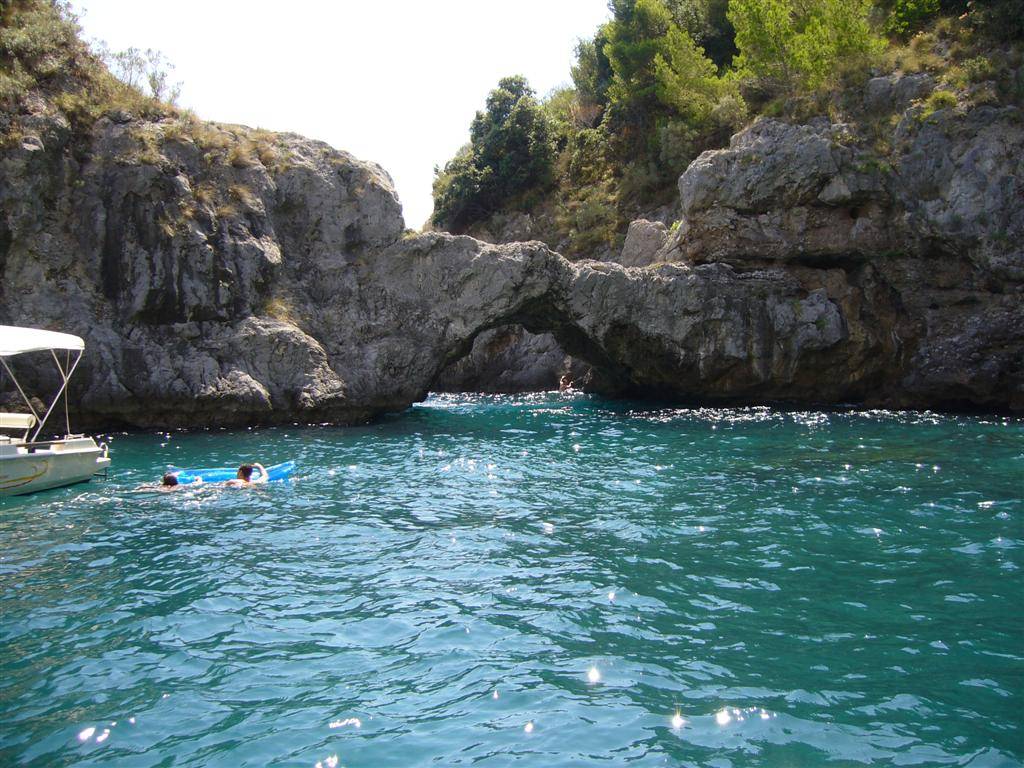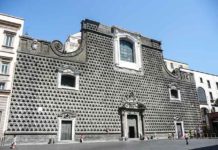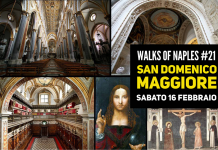Paths dog-out into the rock, favoured accesses to heavenly beaches, were modelled by Greeks, Etruscans, Oscs, and Romans, who built steep stairs and tortuous trails on Terra Felix slopes to connect landing places with the new settlements. They were also a scarecrow for the pirates coming from the sea wanting to assault the villages on the hills. These paths have evocative names, that tell their origin and importance. Every coast in Campania has a track revealing glimpses of heaven, within a stone’s throw from villages and small squares, lemon groves and rivulets. Let’s make a tour among the most popular paths found on tourist maps of Dream Coast and Capri.
Let’s start from the descent to Fiordo of Crapolla, marvellous inlet set between Recommone beach and Punta Taschiero, in Area Marina Protetta of Punta Campanella. A steep 5 km long trail, from the centre of Torca, hamlet of Massa Lubrense, to the small beach below. After a maze of small pathways, near Larito stream and via Cafariello, the slant becomes a path where stands an age-old stair with 800 steps decorated with majolica: the view is stunning. Nearby there’s a chapel dedicated to Saint Peter, who, according to the legend, had stopped there. From the aforementioned chapel starts the descent to the picturesque Marina di Crapolla.
Between Amalfi Coast and Sorrento Peninsula winds the striking “Sentiero degli Dei” (Path of the Gods). Sometimes it is called Sentiero degli Dei the path going from Santa Maria di Castello village to Bomerano, hamlet of Agerola, the so-called “Alto” (high) trail, that continues with a “Basso” (low) trail from Bomerano to Nocelle, hamlet of Positano. This last trail is considered by experts of local history the real “Sentiero degli Dei”, attested in maps and documents since the XVII century. The amazing view offered by this long trail is unique. From Bomerano one arrives to the so-called “Grotta Biscotto”, with old houses set into the mountain. From here, passing near the rock called “il Pinnacolo”, one gets to Colle La Serra and its charming view on the Peninsula, and then to the junction with Praiano path where monastery of San Domenico and the small Nocelle village are worth a visit.[charme-gallery]
From Sentiero degli Dei departs a path leading to Ieranto Bay, one of the most beautiful places of Area Marina Protetta of Punta Campanella, with its view on Capri’s Faraglioni. The term Jeranto derives from ancient Greek “jerax” predacious, because this promontory from above looked like a bird of prey with stretched wings. The name was probably given by the Greek settlers who built a temple dedicated to Athena (later dedicated to Minerva by the Romans).
The trail leading to the bay winds along Monte San Costanzo, starting from Nerano village, hamlet of Massa Lubrense, and giving an amazing view on the coast below Marina del Cantone and on Li Galli islands. From the crossroads of Mont’Alto is possible to visit the tower of guard and the famous Punta Penna, or to go directly on Jeranto beach.
The slant toward the sea winds along an old stair once conducting to a quarry which closed down in 1952. Recently restored by Fondo Ambiente Italiano (Fai), it represents a rare piece of industrial archaeology set into a piece of Eden.
In Amalfi Coast there’s Furore, a small village renowned worldwide for its Fiordo. Actually it isn’t really a fiord but a recess at the outlet of a sheer valley. The Fiordo of Furore has a 30 m high suspension bridge, where every summer is hosted a lap of Great Heights Diving World Championship. A way to reach it is “Volpe Pescatrice” path, a long and narrow stair winding from Carmine square, near Sant’Elia church, to the bay below. The walk, after passing by Palazzo dei Maccaronari, arrives to a little stair leading to the fishing village houses.
Nearby Furore, there are Ravello and Amalfi beaches, like Castiglione beach, hamlet of Ravello, a gem set into the rocks. The cove is tied to the motorway by a 186 steps stair. Also Conca dei Marini, Duoglio and Santacroce beaches can only be reached by means of steep stairs.
Capri, pearl of the Gulf and destination of kings since ancient Romans time, possesses four striking paths connecting the sea with inland.
The most famous is Via Krupp, long 1,3 km, connecting Capri historical centre with Marina Piccola. Via Krupp was built by the German steel magnate Friedrich Alfred Krupp, who bought the area between San Giacomo Chartreuse and Castiglione, and proposed the construction of the road named after him. The project ended in 1902. This panoramic path, drawn from a trail excavated by Friar Felice, a Portuguese monk living into the San Giacomo Chartreuse, has cliffs and terracing falling sheer to the sea. Capri rock is calcareous and therefore very friable, and for this reason Via Krupp has been closed many times.
Capri offers another famous walk: Sentiero dei Fortini, one of the most spectacular of the island. The path coasts the sea from Grotta Azzurra to Punta Carena Lighthouse, among rocks, promontories and deep bays. Its name derives from the three forts that once were used to defend the island: Orrico, Pino and Mesola, built by the English in 1806 and widened by the French after that Napoleon took Capri (4 October 1808).
Then, there’s Scalinata Fenicia, a long and steep stone stair connecting Capri and Anacapri built-up areas. It has 921 steps and it’s 1,7 km long. It was probably built by the Greek settlers to tie the two settlements founded at the time of colonization. Until 1877 Scalinata Fenicia has been the only access to Anacapri. Recently restored, it ends nearby Axel Munthe’s villa San Michele.
Last but not least, the walk of Migliera, an age-old road once linking Anacapri with Belvedere del Tuono. The trail winds from Piazza Vittoria and, through vicoletto Caposcuro and Seggiovia to Monte Solaro station, arrives in Via Migliera, among vineyards, lemon groves, cultivated fields, and a “philosophic park”, where silence and mother nature reign. The walk ends in Belvedere where there’s an amazing view stretching from Punta Carena Lighthouse to Faraglioni.

 Italiano
Italiano














